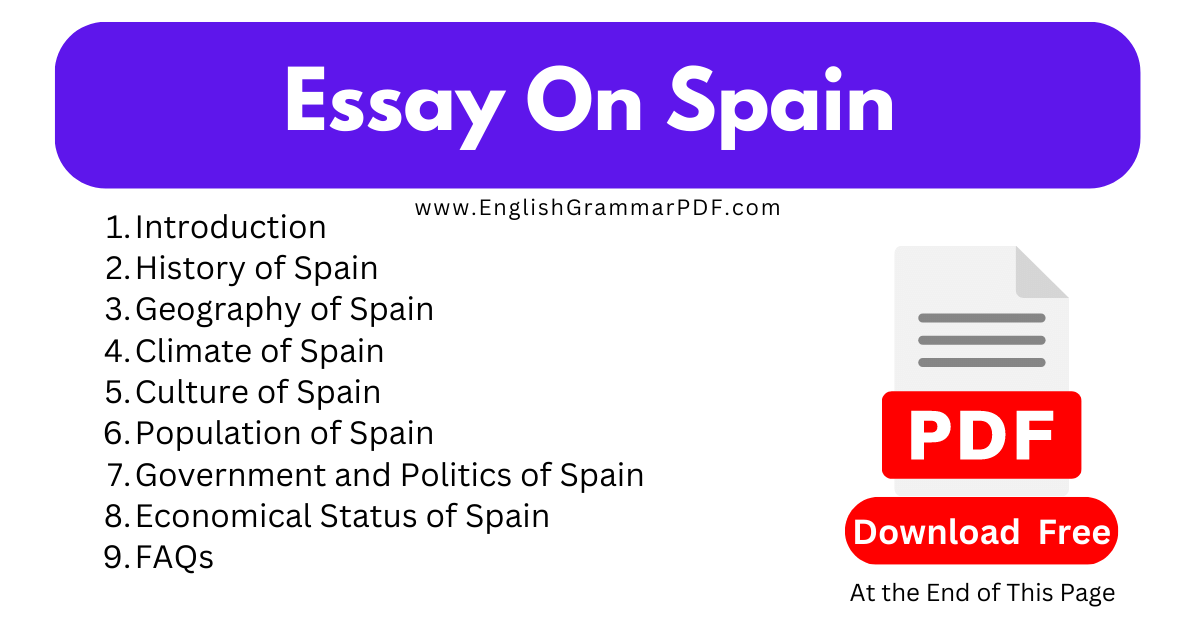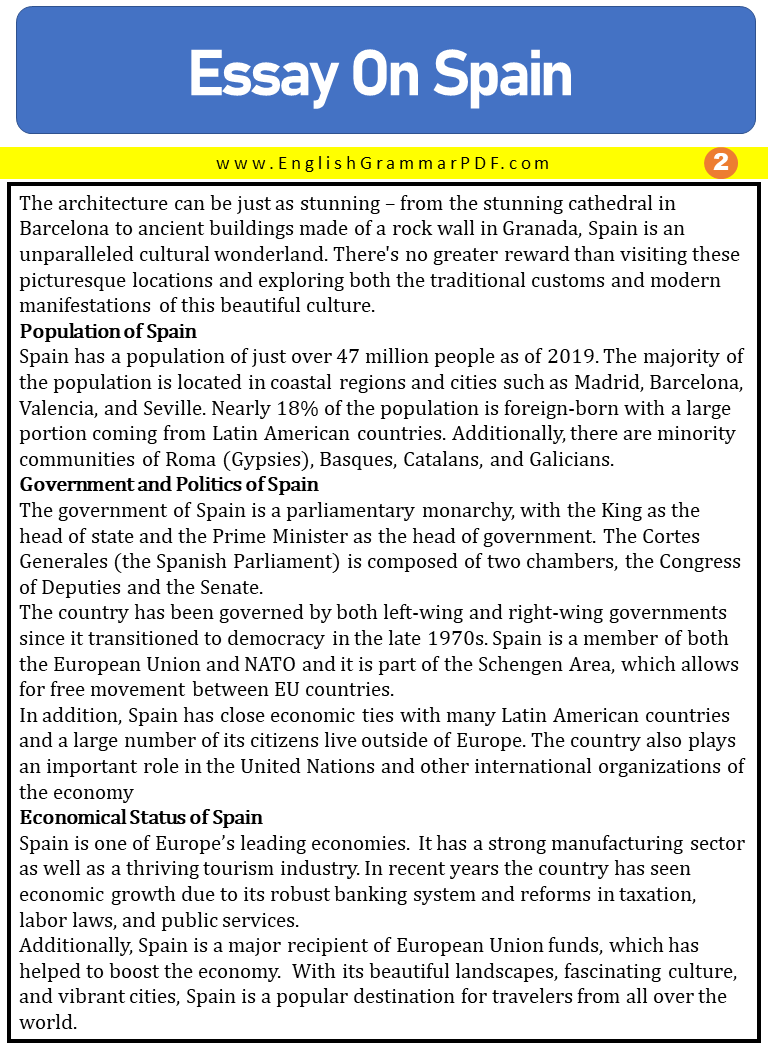Free Essay On Spain – Structure/Outline
- Introduction
- History of Spain
- Geography of Spain
- Climate of Spain
- Culture of Spain
- Population of Spain
- Government and Politics of Spain
- Economical Status of Spain
- FAQs

Introduction
Spain is a beautiful and vibrant country that has seen the rise and fall of many empires throughout its long history. Its location in the southwestern corner of Europe along the Mediterranean Sea makes it an ideal destination for travelers seeking to experience all that Spain has to offer. From stunning architecture to world-renowned cuisine, Spanish culture is a rich source of inspiration, and the vibrant culture of its people adds to the unique experience of visiting this amazing country.
History of Spain
Spain has a long and varied history stretching back thousands of years, making it one of Europe’s oldest nations. It began as a collection of small kingdoms that were eventually unified in 1479 under the rule of the Catholic Monarchs, Ferdinand, and Isabella.
It then went through a period of colonial expansion, with Spain ruling over much of Latin America for centuries. In 1808, Napoleon’s armies invaded Spain and began a long period of conflict with France which lasted until 1814 when the Treaty of Vienna was signed.
In 1931, the Second Spanish Republic was formed and it saw a period of reform. However, this was short-lived as in 1936 General Francisco Franco seized power and declared himself the head of state. Franco’s rule lasted until he died in 1975 when democracy returned to Spain.
Geography of Spain
Spain is located on the Iberian Peninsula in the southwest corner of Europe, bordering France, Portugal, and Gibraltar. It is bordered by the Atlantic Ocean to the northwest and the Mediterranean Sea to the south and east. The country has a total area of 505,992 km2 (195,364 sq mi) making it the 51st largest country in the world.
Spain also has several mountain ranges, including the Pyrenees in the north and the Sierra Nevada in the south. The highest point is Pico de Teide on Tenerife, an island of the Canary Islands off the coast of Africa, which stands at 3,718 m (12,198 ft). In total there are ten national parks located throughout Spain.
Climate of Spain
Spain is known for its sunny, Mediterranean climate, making it a popular destination for tourists every year. But beneath its warm temperatures and clear skies, Spain has a diversity of climates, ranging from the colder temperatures in snow-capped mountain regions to the hot desert wind that blows through Southern Spain.
Along the coastlines of Northern Spain and around the Balearic Islands, there are misty days and the occasional summer storm. In Barcelona and Madrid, people experience humid subtropical weather with cold winters and hot summers. Despite its varied landscapes, Spain experiences little humidity throughout the year—making it an ideal place to explore any season!
Culture of Spain
Spanish culture is deeply rooted in its history and traditions. The country has a strong influence from its Roman, Visigoth, and Muslim pasts. It is also heavily influenced by the Roman Catholic Church, which is the dominant religion in the nation. The Spanish language is one of the official languages of the United Nations and is spoken by over 500 million people worldwide.
The vibrant culture of Spain is renowned around the world. Its people are deeply passionate, often portrayed in their music, dance, and celebrations that evoke a fun, spirited atmosphere. From the traditional flamenco to the electric bull-riding events during festivals, the country’s custom of a passionate lifestyle is alive and well.
The architecture can be just as stunning – from the stunning cathedral in Barcelona to ancient buildings made of a rock wall in Granada, Spain is an unparalleled cultural wonderland. There’s no greater reward than visiting these picturesque locations and exploring both the traditional customs and modern manifestations of this beautiful culture.
Population of Spain
Spain has a population of just over 47 million people as of 2019. The majority of the population is located in coastal regions and cities such as Madrid, Barcelona, Valencia, and Seville. Nearly 18% of the population is foreign-born with a large portion coming from Latin American countries. Additionally, there are minority communities of Roma (Gypsies), Basques, Catalans, and Galicians.
Government and Politics of Spain
The government of Spain is a parliamentary monarchy, with the King as the head of state and the Prime Minister as the head of government. The Cortes Generales (the Spanish Parliament) is composed of two chambers, the Congress of Deputies and the Senate.
The country has been governed by both left-wing and right-wing governments since it transitioned to democracy in the late 1970s. Spain is a member of both the European Union and NATO and it is part of the Schengen Area, which allows for free movement between EU countries.
In addition, Spain has close economic ties with many Latin American countries and a large number of its citizens live outside of Europe. The country also plays an important role in the United Nations and other international organizations of the economy
Economical Status of Spain
Spain is one of Europe’s leading economies. It has a strong manufacturing sector as well as a thriving tourism industry. In recent years the country has seen economic growth due to its robust banking system and reforms in taxation, labor laws, and public services.
Additionally, Spain is a major recipient of European Union funds, which has helped to boost the economy. With its beautiful landscapes, fascinating culture, and vibrant cities, Spain is a popular destination for travelers from all over the world.
From its Roman and Islamic pasts to its strong ties with the Catholic Church, Spain’s rich history makes it a unique and interesting place to explore. With its growing economy, Spain is an attractive option for those looking to invest or do business in Europe. As one of the oldest nations on the continent, Spain has a lot to offer visitors and residents alike.
FAQs
What Spain is famous for?
Spain is known for its beautiful landscapes, vibrant culture, and rich history. It is also famous for its delicious cuisine, flamenco music and dance performances, vibrant festivals, and more.
Is Spain a developed country?
Yes, Spain is a developed country. It has a strong economy and its citizens have access to high-quality healthcare, education, and other public services. Spain also has close economic ties with many Latin American countries and plays an important role in the European Union.
What languages are spoken in Spain?
The official language of Spain is Spanish, though many other languages are spoken as well. These include Catalan, Basque, Galician, and Aranese. Additionally, English is widely spoken in larger cities such as Madrid and Barcelona.
What is the currency of Spain?
The currency of Spain is the Euro (EUR). The euro is used by all European Union countries.
What is the capital of Spain?
The capital and largest city of Spain is Madrid, which is also the country’s political, economic, and cultural center.
Free Essay On Spain (Pictures & PDF)



Related: Free Essay On Sylvia Plath
Download this essay in PDF, Below.


